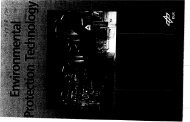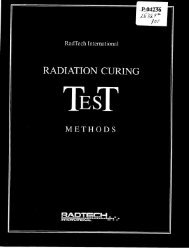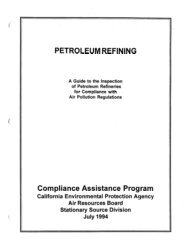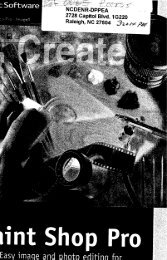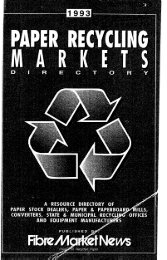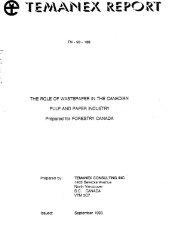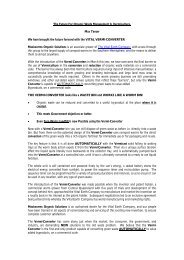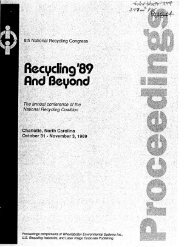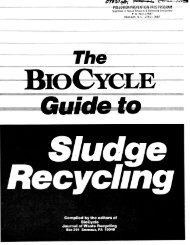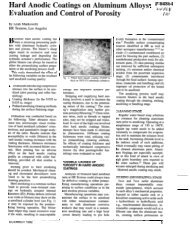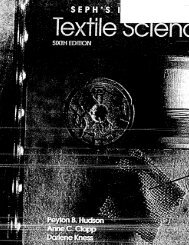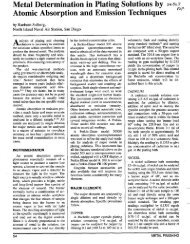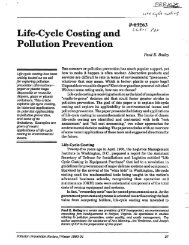Electronic Parts/Guidelines - infoHouse
Electronic Parts/Guidelines - infoHouse
Electronic Parts/Guidelines - infoHouse
You also want an ePaper? Increase the reach of your titles
YUMPU automatically turns print PDFs into web optimized ePapers that Google loves.
Table 4 (Pam 1 of 2). Toxins in Plastics<br />
Another concern with additives to plastics Is flame retardants. Polybrominated<br />
Biphenyls and polybrominated biphenyl oxides (PBBs/PBBOs) are targeted for<br />
total elimination from plastic packaging, specifically foam cushioning. This ban<br />
was driven by a Dutch Law passed in 1993. The reason for banning PBBs and<br />
PBBOs is that when the materials containing these compounds are disposed,<br />
bromo-dioxins and/or bromo-furans can be generated which are toxic because<br />
these compounds accumulate In the tissue of humans, animals and in plants.<br />
Addltke Purposa Typlwl Compounds<br />
Flame<br />
retardants<br />
Heat<br />
Stabilizers<br />
Lubricants<br />
Plasticizers<br />
Added to plastics to yield products that will ignite and burn<br />
with greater difficulty than untreated plastics. Current<br />
research efforts include minimizing the toxic smoke and<br />
gas assodated with the burning of plastics, particularly as<br />
it relates to unexpected fires in buildings.<br />
Used to ensure product durability. Heat stabilizers are<br />
Important additions to heat-sensitive polymers that<br />
undergo relatively high temperatures to soften them during<br />
fabricatino omratlons.<br />
Function to decrease the viscosity of the resin melt and to<br />
control resin-to-melt friction during plastics processing.<br />
Thew additives also lower the die swell of extrudates and<br />
promote surface gloss.<br />
Added to Dolvmers such as PVC to make them soft and - Phthalates<br />
flexible. Pla6ticizers are also used to improve melt<br />
* Adipates<br />
processlbllity and toughness of rigid plastics such as<br />
* Phosphates<br />
c~llulow esters and ethers, and in a variety of specialized<br />
aDDlications.<br />
* Epoxy<br />
Polvesters<br />
*Aluminum trihydrate (ATH)<br />
* Organic phosphates<br />
'Antimony oxides<br />
* Organic halogen compounds<br />
Boron compounds<br />
Polybrominated byphenyl com-<br />
pounds (PBBs and PBBOs)<br />
* Liquid organotin compounds and<br />
tin mercaptide6<br />
Barium/cadmium concentrates<br />
* Barium/zinc/lead additives<br />
Metallic stearates<br />
.Waxes, fatty acids and mineral oil<br />
* Silicones . Molybdenum<br />
* Polyfluorocarbons<br />
Required in the stabilization of ABS, polypropylene,<br />
* Primary antioxidants such as<br />
butylated hydroxytoluene (BHT)<br />
polyethylene and polystyrene plastics. These additives Secondary antioxidants such as<br />
Antioxidants may be free radical scavengers (primary oxidants) or dilauryl thiodipropionate and<br />
peroxide decomposers (sewndary antioxidants). trisphosphite<br />
PhosDhite/ohenolic blends<br />
Ultravidet<br />
(UV)<br />
Stabilizers<br />
Function to prevent degradation of plastics by UV radiation<br />
such as occurs in sunlight. Many organic UV stabilizers<br />
tend to migrate to the polymer surface.<br />
Used in the production of cellular plastics such as foamed<br />
Blowing insulation, and plastic film, sheet and pipe obtained by<br />
Agents extrusion.<br />
Colorants<br />
Added to achieve the desired color of the final product.<br />
Color may be compounded into the resin and sold as such.<br />
In other instances, the end-user blends the appropriate<br />
amount of dry wlor powder with resin and produces the<br />
final wlorpart. Currently, color is frequently added as<br />
pellet concentrates or direct-feed liquids to minimize occu-<br />
pational exposure to colorants.<br />
Hindered amine stabilizers<br />
*Zinc oxide and nickel complexes<br />
* Benzophenonesand<br />
benzotriazoles<br />
0 Carbon black<br />
* Phosohite co-stabilizers<br />
Fluorocarbons<br />
Chemical blowing agents (CBA)<br />
such as azodicarbonamlde and<br />
sulfone hydrazide<br />
* High temperature blowing agents<br />
1HTBAI<br />
*Titanium dioxide<br />
*Carbon black<br />
Inorganic colorants such as iron<br />
oxides, cadmium, chromium, lead,<br />
nickeland molybdate<br />
Organic colorants such as<br />
phthalocyanines, nigrosines and<br />
others<br />
TOXIC Material Reduction 19



